Assessing the Extent of Flood-Prone Areas in a South-American Megacity Using Different High Resolution DTMs
Abstract
:1. Introduction
2. Materials and Methods
2.1. Study Area
2.2. Case Study: The Extreme Event of March 2019
2.3. Dataset and Computer Settings
2.4. HEC-RAS
2.4.1. Theoretical Foundation
2.4.2. HEC-RAS Simulation
2.5. Validation
3. Results
4. Discussion
5. Conclusions
Supplementary Materials
Author Contributions
Funding
Data Availability Statement
Acknowledgments
Conflicts of Interest
References
- United Nations (UN). World Population Prospects 2022. Summary of Results; United Nations (UN): New York, NY, USA, 2022.
- United Nations Office for Disaster Risk Reduction (UNDRR). Global Assessment Report on Disaster Risk Reduction 2019; United Nations Office for Disaster Risk Reduction (UNDRR): Geneva, Switzerland, 2019. [Google Scholar]
- United Nations (UN). World Urbanization Prospects: The 2018 Revision; United Nations, Department of Economic and Social Affairs, Population Division, Eds.; United Nations (UN): New York, NY, USA, 2019; ISBN 9211483190.
- Angel, S.; Parent, J.; Civco, D.L.; Blei, A.; Potere, D. The dimensions of global urban expansion: Estimates and projections for all countries 2000–2050. Prog. Plan. 2011, 75, 53–107. [Google Scholar] [CrossRef]
- Angel, S.; Parent, J.; Civco, D.L.; Blei, A.M. Atlas of Urban Expansion—The 2016 Edition Volum 1: Areas and Densities; NYU Urban Expansion Program at New York University, UN-Habitat, and the Lincoln Institute of Land Policy: New York, NY, USA, 2016; ISBN 978-1-55844-243-6. Available online: https://www.lincolninst.edu/sites/default/files/pubfiles/atlas-of-urban-expansion-2016-volume-1-full.pdf (accessed on 15 November 2022).
- Hardoy, J.E.; Mitlin, D.; Satterthwaite, D. Environmental Problems in an Urbanizing World: Finding Solutions for Cities in Africa, Asia and Latin America, 2nd ed.; Routledge: London, UK, 2013; ISBN 9781853837197. [Google Scholar]
- Grimm, N.B.; Faeth, S.H.; Golubiewski, N.E.; Redman, C.L.; Wu, J.; Bai, X.; Briggs, J.M. Global change and the ecology of cities. Science 2008, 319, 756–760. [Google Scholar] [CrossRef] [PubMed] [Green Version]
- Faulkner, S. Urbanization impacts on the structure and function of forested wetlands. Urban Ecosyst. 2004, 7, 89–106. [Google Scholar] [CrossRef]
- Semadeni-Davies, A.; Hernebring, C.; Svensson, G.; Gustafsson, L.-G. The impacts of climate change and urbanisation on drainage in helsingborg, sweden: Combined sewer system. J. Hydrol. 2008, 350, 100–113. [Google Scholar] [CrossRef]
- White, M.D.; Greer, K.A. The effects of watershed urbanization on the stream hydrology and riparian vegetation of los peñasquitos creek, California. Landsc. Urban Plan. 2006, 74, 125–138. [Google Scholar] [CrossRef]
- Grabs, W.; Tyagi, A.C.; Hyodo, M. Integrated flood management. Water Sci. Technol. 2007, 56, 97–103. [Google Scholar] [CrossRef] [PubMed]
- World Meteorological Organization (WMO). Atlas of Mortality and Economic Losses from Weather, Climate and Water Extremes (1970–2019); WMO-No. 12; World Meteorological Organization: Geneva, Switzerland, 2021; ISBN 9789263112675. [Google Scholar]
- Centre for Research on the Epidemiology of Disasters (CRED). Disasters in Numbers. Available online: https://cred.be/sites/default/files/2021_EMDAT_report.pdf (accessed on 23 January 2023).
- Emilsson, T.; Sang, Å.O. Impacts of Climate Change on Urban Areas and Nature-Based Solutions for Adaptation. In Nature-Based Solutions to Climate Change Adaptation in Urban Areas; Kabisch, N., Korn, H., Stadler, J., Bonn, A., Eds.; Theory and Practice of Urban Sustainability Transitions; Springer International Publishing: Cham, Switzerland, 2017; pp. 15–27. ISBN 978-3-319-53750-4. [Google Scholar]
- Center for Studies and Research in Engineering and Civil Defense (CEPED) Atlas Brasileiro de Desastres Naturais: 1991 A 2012, 2nd ed.; Universidade Federal de Santa Catarina: Florianópolis, Brazil, 2013.
- Sprissler, T. Flood Risk in Brazil: Prevention, Adaptation and Insurance; Chennell, J., Heard, R., Eds.; Swiss Re: Zurich, Switzerland, 2011. [Google Scholar]
- Integrated Disaster Information System (Sistema Integrado de Informações sobre Desastres—S2iD). Management Report—Reported Damages (Relatório Gerencial—Danos Informados). 2023. Available online: https://s2id.mi.gov.br/ (accessed on 15 January 2023).
- Jha, A.K.; Bloch, R.; Lamond, J. Cities and Flooding: A Guide to Integrated Urban Flood Risk Management for the 21st Century; The World Bank: Washington, DC, USA, 2012; ISBN 978-0-8213-8866-2. [Google Scholar]
- Rosenzweig, B.R.; Herreros Cantis, P.; Kim, Y.; Cohn, A.; Grove, K.; Brock, J.; Yesuf, J.; Mistry, P.; Welty, C.; McPhearson, T.; et al. The value of urban flood modeling. Earths Future 2021, 9, 9. [Google Scholar] [CrossRef]
- Neal, J.C.; Bates, P.D.; Fewtrell, T.J.; di Baldassarre, G. Urban Flood Modelling. In Floods in a Changing Climate: Inundation Modelling; Cambridge University Press: Cambridge, UK, 2012; pp. 69–77. [Google Scholar]
- Teng, J.; Jakeman, A.J.; Vaze, J.; Croke, B.F.W.; Dutta, D.; Kim, S. Flood inundation modelling: A review of methods, recent advances and uncertainty analysis. Environ. Model. Softw. 2017, 90, 201–216. [Google Scholar] [CrossRef]
- Salvadore, E.; Bronders, J.; Batelaan, O. Hydrological modelling of urbanized catchments: A review and future directions. J. Hydrol. 2015, 529, 62–81. [Google Scholar] [CrossRef]
- Rangari, V.A.; Umamahesh, N.V.; Bhatt, C.M. Assessment of inundation risk in urban floods using HEC RAS 2D. Model. Earth Syst. Environ. 2019, 5, 1839–1851. [Google Scholar] [CrossRef]
- Tomás, L.R.; Soares, G.G.; Jorge, A.A.S.; Mendes, J.F.; Freitas, V.L.S.; Santos, L.B.L. Flood risk map from hydrological and mobility data: A case study in são paulo (Brazil). Trans. GIS 2022, 26, 2341–2365. [Google Scholar] [CrossRef]
- Rennó, C.D.; Nobre, A.D.; Cuartas, L.A.; Soares, J.V.; Hodnett, M.G.; Tomasella, J.; Waterloo, M.J. HAND, a new terrain descriptor using SRTM-DEM: Mapping terra-firme rainforest environments in Amazonia. Remote Sens. Environ. 2008, 112, 3469–3481. [Google Scholar] [CrossRef]
- Silva, C.V.F.; Oliveira, C.P.M.; Garcia, J.I.B.; Yazaki, L.F.O.L.; Natale, O.; Brites, A.P.Z. Scenario Evaluation of Alternatives for Flood Control in the Anhangabaú Watershed, Brazil. In Proceedings of the 6th International Conference on Flood Management, São Paulo, Brazil, 16–18 September 2014. [Google Scholar]
- Oliveira, C.P.M.; Silva, C.V.F.; Sosnoski, A.S.K.B.; Bozzini, P.L.; Rossi, D.M.; Uemura, S.; Conde, F. Warning System Based on Real-Time Flood Forecasts in São Paulo, Brazil. In Proceedings of the 6th International Conference on Flood Management, São Paulo, Brazil, 16–18 September 2014. [Google Scholar]
- Brazilian Institute of Geography and Statistics (IBGE). Cidades e Estados (‘Cities and States’). 2023. Available online: https://www.ibge.gov.br/cidades-e-estados/sp/sao-caetano-do-sul.html (accessed on 20 July 2022).
- Brazilian Institute of Geography and Statistics (IBGE). Gross Internal Product of the Brazil’s Municipalities 2018 (‘Produto Interno Bruto Dos Municípios 2018′); IBGE, Ed.; Coordenação de Contas Nacionais: Rio de Janeiro, Brazil, 2020; ISBN 9786587201399. [Google Scholar]
- Sustainable Cities Institute (Instituto Cidades Sustentáveis—ICS). Development Index: Brazil (‘Índice de Desenvolvimento Sustentável Das Cidades: Brasil’). 2022. Available online: https://idsc.cidadessustentaveis.org.br/rankings (accessed on 30 January 2023).
- Escobar-Silva, E.V.; de Almeida, C.M.; Carvalho, R.M.; de Oliveira, C.G. Generation of a Digital Terrain Model (DTM) in Urban Areas by Means of Very High-Resolution Satellite Images and Combined to a Bathymetric. Bull. Geod. Sci. 2023, in press. [Google Scholar]
- Beck, H.E.; Zimmermann, N.E.; McVicar, T.R.; Vergopolan, N.; Berg, A.; Wood, E.F. Present and future Köppen-Geiger climate classification maps at 1-km resolution. Sci. Data 2018, 5, 180214. [Google Scholar] [CrossRef] [Green Version]
- CLIMATE-DATA.ORG. Climate São Caetano Do Sul. Available online: https://en.climate-data.org/south-america/brazil/sao-paulo/sao-caetano-do-sul-9603/ (accessed on 31 January 2023).
- Moroz-Caccia Gouveia, I.C.; Rodrigues, C. Mudanças Morfológicas e efeitos hidrodinâmicos do processo de urbanização na bacia hidrográfica do rio Tamanduateí—RMSP. GEOUSP Espaço Tempo (Online) 2017, 21, 257. [Google Scholar] [CrossRef] [Green Version]
- Civil Defense. Disaster Information Form (Formulário de Informações do Desastre—FIDE). Protocol No. SP-F-3548807-13214-20190310. 2019. Report with restricted access.
- G1. Chuva Faz Rua de São Caetano Ficar Com Quase 2 Metros de Água. Available online: https://g1.globo.com/sp/sao-paulo/noticia/2019/03/11/rua-de-sao-caetano-tem-quase-2-metros-de-agua-e-mais-de-20-enchentes-em-35-anos.ghtml (accessed on 23 January 2023).
- Seidel, E. Fortes Chuvas Provocam Alagamentos Em São Paulo e Região Metropolitana. Available online: https://mobilidadesampa.com.br/2019/03/fortes-chuvas-provocam-alagamentos-em-sao-paulo-e-regiao-metropolitana/ (accessed on 23 January 2023).
- National Water Resources Information System (Sistema Nacional de Informação de Recursos Hídricos—SNIRH). HidroWeb. Available online: https://www.snirh.gov.br/hidroweb/mapa (accessed on 6 July 2022).
- Ferraro, D.; Costabile, P.; Costanzo, C.; Petaccia, G.; Macchione, F. A Spectral Analysis Approach for the a Priori Generation of Computational Grids in the 2-D Hydrodynamic-Based Runoff Simulations at a Basin Scale. J. Hydrol. 2020, 582, 124508. [Google Scholar] [CrossRef]
- São Paulo Company for Metropolitan Planning (EMPLASA). Digital Terrain Models; São Paulo Company for Metropolitan Planning (EMPLASA): São Paulo, Brazil, 2013; Digital data with restricted access. [Google Scholar]
- Brunner, G.W. HEC-RAS: River Analysis System—User’s Manual Version 6.0; US Army Corps of Engineers, Institute for Water Resources, Hydrologic Engineering Center (HEC): Davis, CA, USA, 2021. [Google Scholar]
- Xiong, Y. A Dam break analysis using HEC-RAS. J. Water Resour. Prot. 2011, 3, 370–379. [Google Scholar] [CrossRef]
- Ahmad, H.F.; Alam, A.; Bhat, M.S.; Ahmad, S. One dimensional steady flow analysis using HECRAS—A case of River Jhelum, Jammu and Kashmir. Eur. Sci. J. 2016, 12, 340. [Google Scholar] [CrossRef]
- Quirogaa, V.M.; Kurea, S.; Udoa, K.; Manoa, A. Application of 2D numerical simulation for the analysis of the February 2014 bolivian amazonia flood: Application of the new HEC-RAS version 5. Ribagua 2016, 3, 25–33. [Google Scholar] [CrossRef] [Green Version]
- Zainalfikry, M.K.; Ab Ghani, A.; Zakaria, N.A.; Chan, N.W. HEC-RAS One-Dimensional Hydrodynamic Modelling for Recent Major Flood Events in Pahang River. In Proceedings of the AICCE’19: Transforming the Nation for a Sustainable Tomorrow; Springer International Publishing: Cham, Switzerland, 2020; pp. 1099–1115. [Google Scholar]
- Garcia, M.; Juan, A.; Bedient, P. Integrating reservoir operations and flood modeling with HEC-RAS 2D. Water 2020, 12, 2259. [Google Scholar] [CrossRef]
- Urzică, A.; Mihu-Pintilie, A.; Stoleriu, C.C.; Cîmpianu, C.I.; Huţanu, E.; Pricop, C.I.; Grozavu, A. Using 2D HEC-RAS modeling and embankment dam break scenario for assessing the flood control capacity of a Multi-Reservoir system (NE Romania). Water 2020, 13, 57. [Google Scholar] [CrossRef]
- Dasallas, L.; Kim, Y.; An, H. Case study of HEC-RAS 1D–2D coupling simulation: 2002 baeksan flood event in Korea. Water 2019, 11, 2048. [Google Scholar] [CrossRef] [Green Version]
- Brunner, G.W. HEC-RAS: River Analysis System Hydraulic Reference Manual; Hydrologic Engineering Center: Davis, CA, USA, 2021. [Google Scholar]
- Marques-Carvalho, R.; de Almeida, C.M.; Escobar-Silva, E.V.; de Oliveira Alves, R.B.; Anjos Lacerda, C.S. dos simulation and prediction of urban land use change considering multiple classes and transitions by means of random change allocation algorithms. Remote Sens 2022, 15, 90. [Google Scholar] [CrossRef]
- Instituto Geográfico e Cartográfico—IGC. Ortofotos e Modelos Digitais de Superfície—2010/2011. Available online: http://www.igc.sp.gov.br/produtos/listagem_emplasa.html (accessed on 21 February 2023).
- American Society for Photogrammetry and Remote Sensing (ASPRS). ASPRS positional accuracy standards for digital geospatial data. Photogramm. Eng. Remote Sens. 2015, 81, 1–26. [Google Scholar] [CrossRef]
- Hawker, L.; Bates, P.; Neal, J.; Rougier, J. Perspectives on digital elevation model (dem) simulation for flood modeling in the absence of a high-accuracy open access global dem. Front. Earth Sci. 2018, 6. [Google Scholar] [CrossRef] [Green Version]
- Xu, K.; Fang, J.; Fang, Y.; Sun, Q.; Wu, C.; Liu, M. The importance of digital elevation model selection in flood simulation and a proposed method to reduce dem errors: A case study in Shanghai. Int. J. Disaster Risk Sci. 2021, 12, 890–902. [Google Scholar] [CrossRef]
- Xing, Y.; Chen, H.; Liang, Q.; Ma, X. Improving the performance of city-scale hydrodynamic flood modelling through a GIS-based DEM Correction Method. Nat. Hazards 2022, 112, 2313–2335. [Google Scholar] [CrossRef]
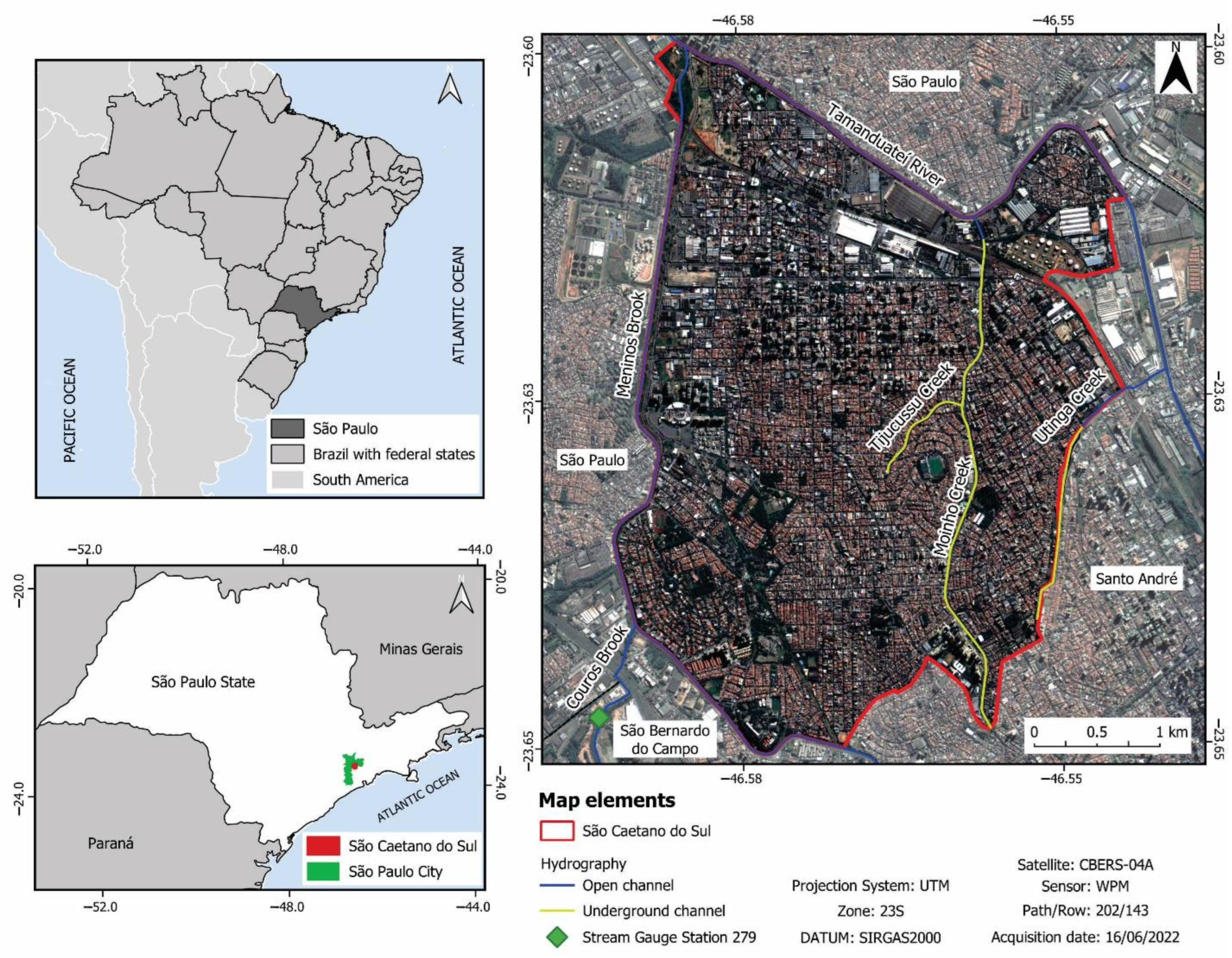
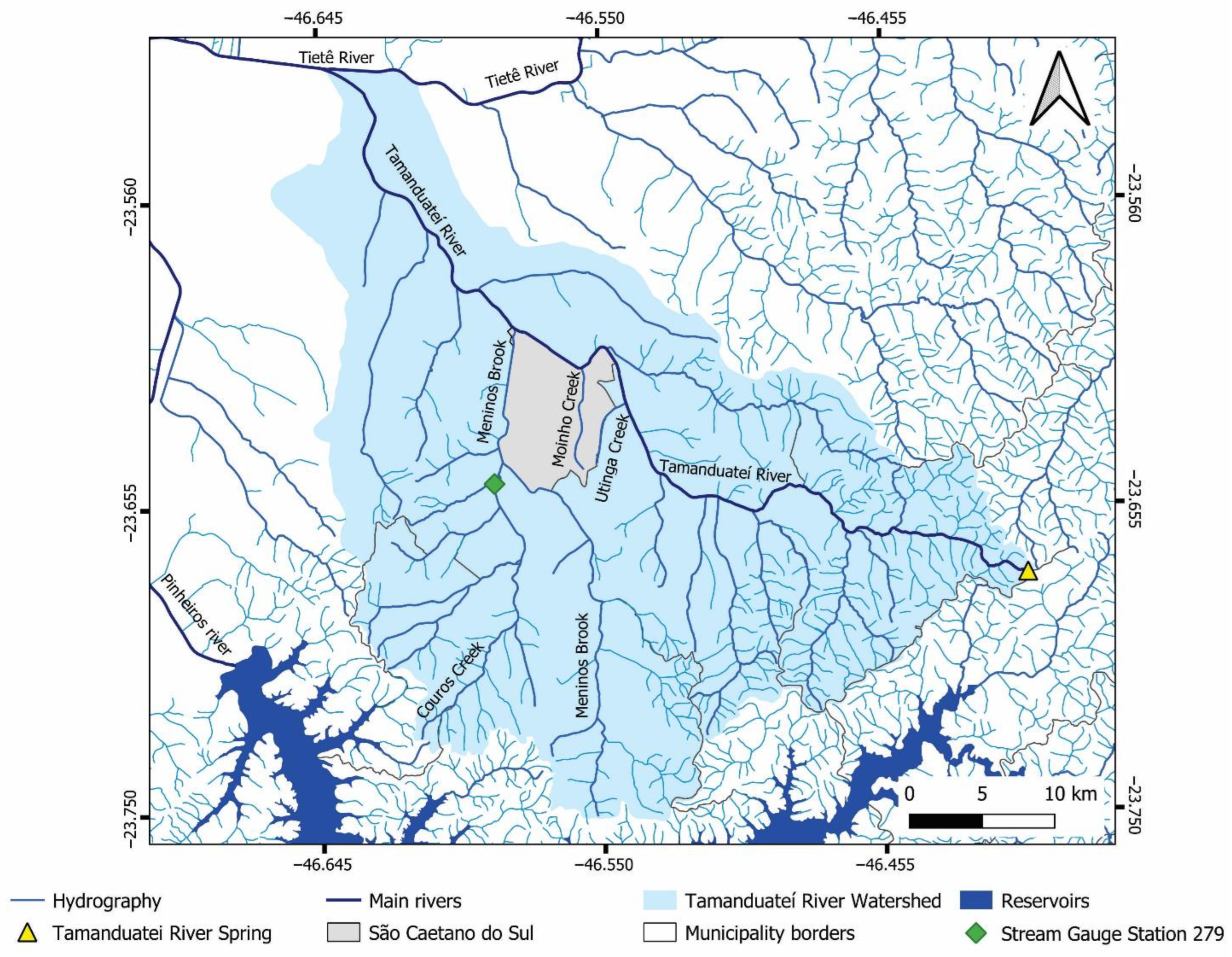
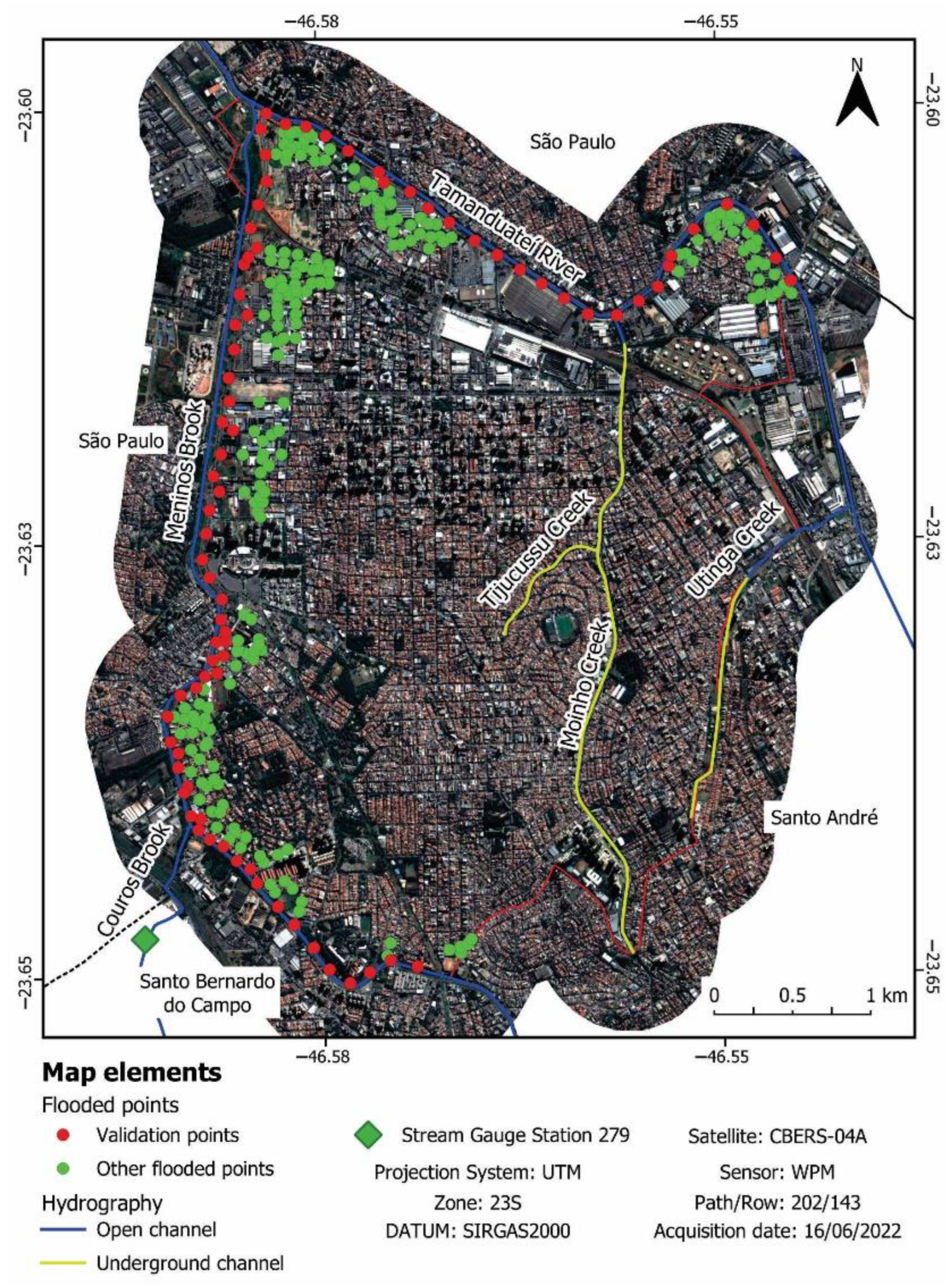


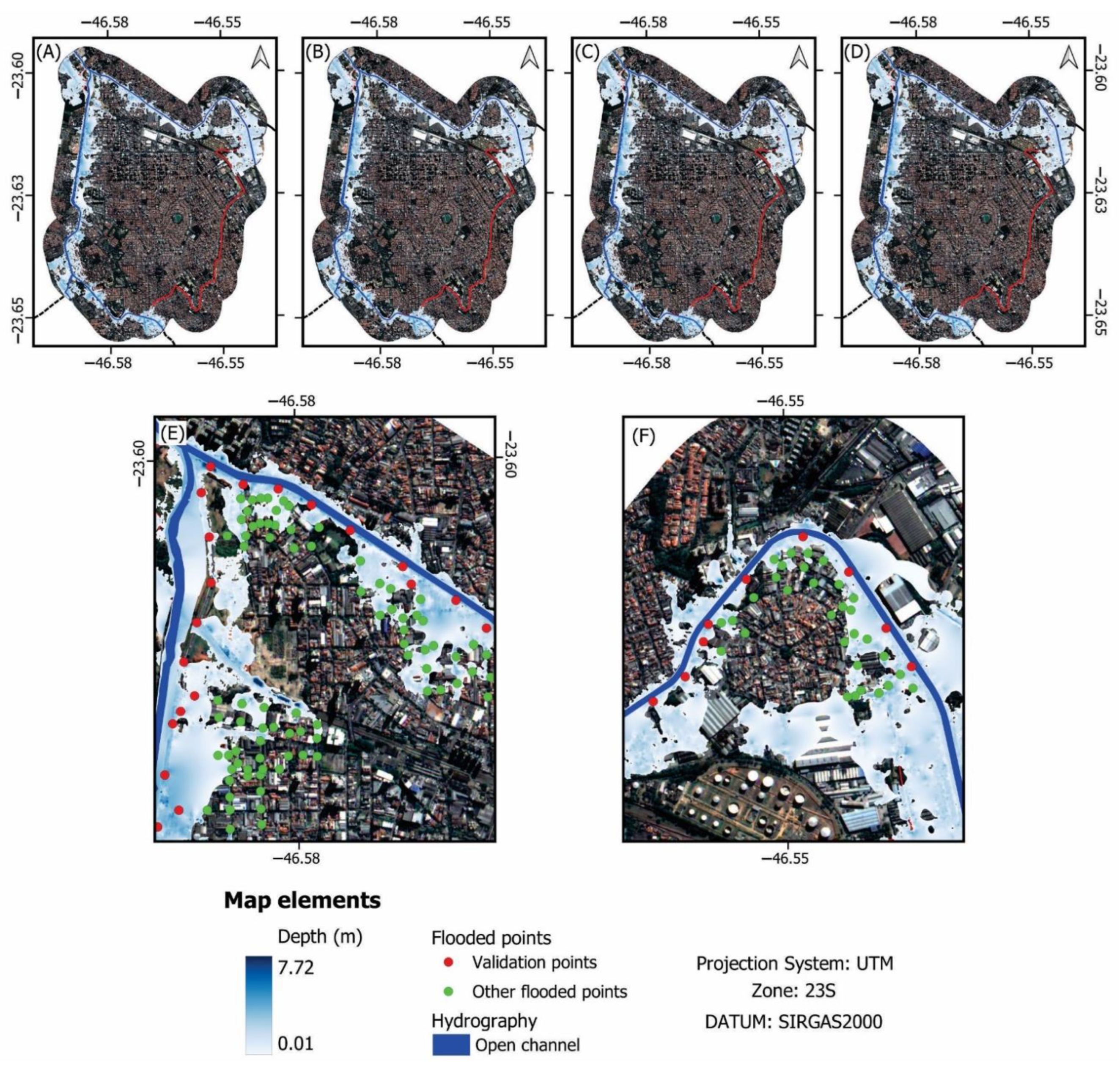
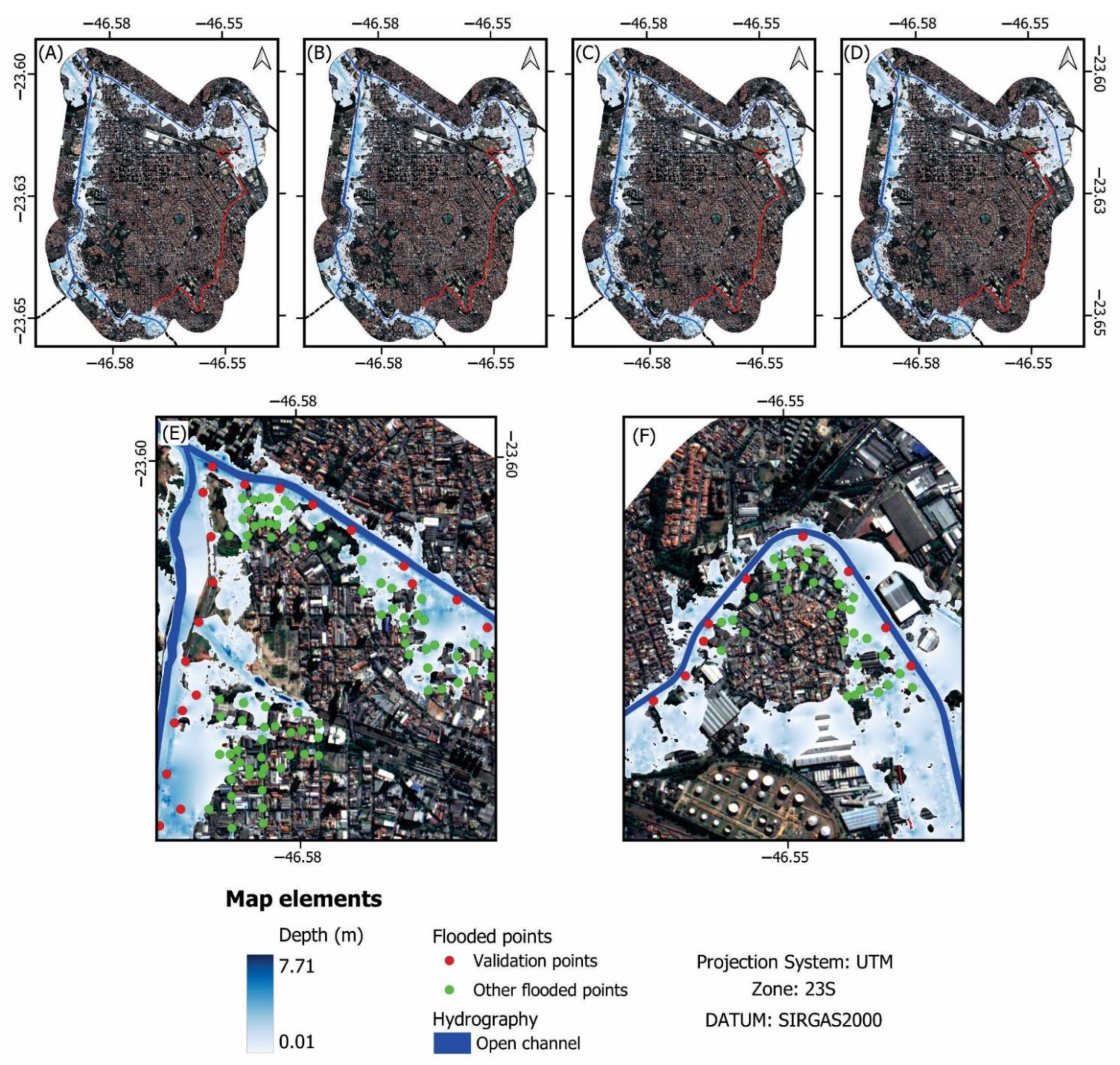
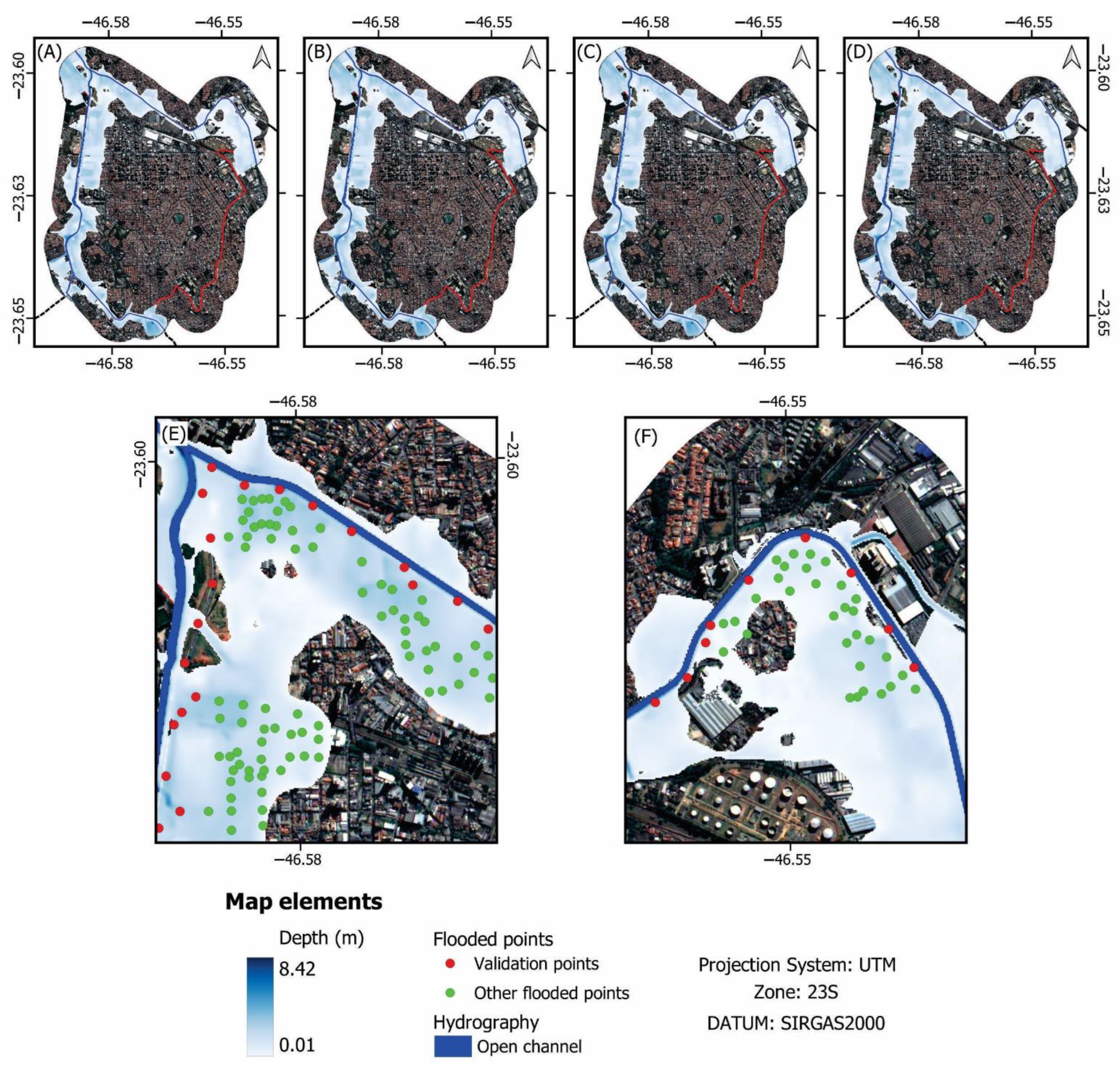
| Year (Descending Order) | Number of Events Per Year | Dates of Occurrence (Day/Month) | |||
|---|---|---|---|---|---|
| 2022 | 4 | 02/02 | 17/02 | 01/03 | 12/03 |
| 2021 | 1 | 18/11 | |||
| 2020 | 3 | 08/01 | 19/02 | 24/02 | |
| 2019 | 3 | 04/02 | 15/02 | 10/03 | |
| 2018 | 2 | 17/10 | 23/11 | ||
| 2017 | 3 | 06/02 | 06/04 | 27/11 | |
| 2016 | 2 | 15/02 | 06/06 | ||
| 2015 | 1 | 27/01 | |||
| 2012 | 2 | 17/01 | 28/11 | ||
| 2011 | 2 | 15/11 | 14/12 | ||
| 2010 | 1 | 17/02 | |||
| 2008 | 1 | 21/02 | |||
| 2005 | 1 | 11/01 | |||
| 2002 | 1 | 28/11 | |||
| 2000 | 2 | 12/01 | 26/01 | ||
| Finer DTM | Finer DTM | Finer DTM | Finer DTM | |
|---|---|---|---|---|
| Computing intervals | 1 s | 15 s | 30 s | 60 s |
| Mean (m) | 0.805 | 0.806 | 0.806 | 0.808 |
| Standard deviation (m) | 1.215 | 1.215 | 1.215 | 1.215 |
| Range (m) | 4.910 | 4.909 | 4.910 | 4.913 |
| Minimum (m) | –1.552 | –1.552 | –1.551 | –1.549 |
| Maximum (m) | 3.357 | 3.358 | 3.359 | 3.364 |
| Missing points | 5 | 5 | 5 | 5 |
| Computation time (hh:mm:ss) | 02:40:30 | 00:55:32 | 00:30:24 | 00:16:58 |
| Finer DTM with Refined Channel Mesh | Finer DTM with Refined Channel Mesh | Finer DTM with Refined Channel Mesh | Finer DTM with Refined Channel Mesh | |
|---|---|---|---|---|
| Computing intervals | 1 s | 15 s | 30 s | 60 s |
| Mean (m) | 0.809 | 0.810 | 0.811 | 0.813 |
| Standard deviation (m) | 1.210 | 1.210 | 1.210 | 1.210 |
| Range (m) | 5.038 | 5.038 | 5.039 | 5.040 |
| Minimum (m) | –1.626 | –1.625 | −1.624 | –1.621 |
| Maximum (m) | 3.412 | 3.413 | 3.414 | 3.420 |
| Missing points | 5 | 5 | 5 | 5 |
| Computation time (hh:mm:ss) | 21:08:20 | 02:50:31 | 01:37:39 | 00:50:59 |
| EMPLASA DTM | EMPLASA DTM | EMPLASA DTM | EMPLASA DTM | |
|---|---|---|---|---|
| Computing intervals | 1 s | 15 s | 30 s | 60 s |
| Mean (m) | 0.591 | 0.591 | 0.592 | 0.596 |
| Standard deviation (m) | 0.966 | 0.966 | 0.966 | 0.964 |
| Range (m) | 4.493 | 4.493 | 4.492 | 4.484 |
| Minimum (m) | –1.577 | –1.576 | –1.575 | –1.566 |
| Maximum (m) | 2.917 | 2.917 | 2.917 | 2.917 |
| Missing points | 3 | 3 | 3 | 3 |
| Computation time (hh:mm:ss) | 03:13:51 | 00:50:46 | 00:30:51 | 00:19:46 |
Disclaimer/Publisher’s Note: The statements, opinions and data contained in all publications are solely those of the individual author(s) and contributor(s) and not of MDPI and/or the editor(s). MDPI and/or the editor(s) disclaim responsibility for any injury to people or property resulting from any ideas, methods, instructions or products referred to in the content. |
© 2023 by the authors. Licensee MDPI, Basel, Switzerland. This article is an open access article distributed under the terms and conditions of the Creative Commons Attribution (CC BY) license (https://creativecommons.org/licenses/by/4.0/).
Share and Cite
Escobar-Silva, E.V.; Almeida, C.M.d.; Silva, G.B.L.d.; Bursteinas, I.; Rocha Filho, K.L.d.; de Oliveira, C.G.; Fagundes, M.R.; Paiva, R.C.D.d. Assessing the Extent of Flood-Prone Areas in a South-American Megacity Using Different High Resolution DTMs. Water 2023, 15, 1127. https://doi.org/10.3390/w15061127
Escobar-Silva EV, Almeida CMd, Silva GBLd, Bursteinas I, Rocha Filho KLd, de Oliveira CG, Fagundes MR, Paiva RCDd. Assessing the Extent of Flood-Prone Areas in a South-American Megacity Using Different High Resolution DTMs. Water. 2023; 15(6):1127. https://doi.org/10.3390/w15061127
Chicago/Turabian StyleEscobar-Silva, Elton Vicente, Cláudia Maria de Almeida, Gustavo Barbosa Lima da Silva, Ingobert Bursteinas, Kleber Lopes da Rocha Filho, Cleber Gonzales de Oliveira, Marina Refatti Fagundes, and Rodrigo Cauduro Dias de Paiva. 2023. "Assessing the Extent of Flood-Prone Areas in a South-American Megacity Using Different High Resolution DTMs" Water 15, no. 6: 1127. https://doi.org/10.3390/w15061127
APA StyleEscobar-Silva, E. V., Almeida, C. M. d., Silva, G. B. L. d., Bursteinas, I., Rocha Filho, K. L. d., de Oliveira, C. G., Fagundes, M. R., & Paiva, R. C. D. d. (2023). Assessing the Extent of Flood-Prone Areas in a South-American Megacity Using Different High Resolution DTMs. Water, 15(6), 1127. https://doi.org/10.3390/w15061127








